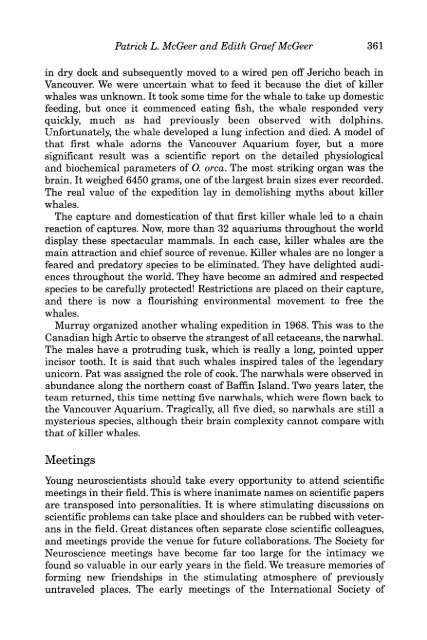Edith Graef McGeer - Society for Neuroscience
Edith Graef McGeer - Society for Neuroscience
Edith Graef McGeer - Society for Neuroscience
Create successful ePaper yourself
Turn your PDF publications into a flip-book with our unique Google optimized e-Paper software.
Patrick L. <strong>McGeer</strong> and <strong>Edith</strong> <strong>Graef</strong><strong>McGeer</strong> 361<br />
in dry dock and subsequently moved to a wired pen off Jericho beach in<br />
Vancouver. We were uncertain what to feed it because the diet of killer<br />
whales was unknown. It took some time <strong>for</strong> the whale to take up domestic<br />
feeding, but once it commenced eating fish, the whale responded very<br />
quickly, much as had previously been observed with dolphins.<br />
Un<strong>for</strong>tunately, the whale developed a lung infection and died. A model of<br />
that first whale adorns the Vancouver Aquarium foyer, but a more<br />
significant result was a scientific report on the detailed physiological<br />
and biochemical parameters of O. orca. The most striking organ was the<br />
brain. It weighed 6450 grams, one of the largest brain sizes ever recorded.<br />
The real value of the expedition lay in demolishing myths about killer<br />
whales.<br />
The capture and domestication of that first killer whale led to a chain<br />
reaction of captures. Now, more than 32 aquariums throughout the world<br />
display these spectacular mammals. In each case, killer whales are the<br />
main attraction and chief source of revenue. Killer whales are no longer a<br />
feared and predatory species to be eliminated. They have delighted audiences<br />
throughout the world. They have become an admired and respected<br />
species to be carefully protected! Restrictions are placed on their capture,<br />
and there is now a flourishing environmental movement to free the<br />
whales.<br />
Murray organized another whaling expedition in 1968. This was to the<br />
Canadian high Artie to observe the strangest of all cetaceans, the narwhal.<br />
The males have a protruding tusk, which is really a long, pointed upper<br />
incisor tooth. It is said that such whales inspired tales of the legendary<br />
unicorn. Pat was assigned the role of cook. The narwhals were observed in<br />
abundance along the northern coast of Baffin Island. Two years later, the<br />
team returned, this time netting five narwhals, which were flown back to<br />
the Vancouver Aquarium. Tragically, all five died, so narwhals are still a<br />
mysterious species, although their brain complexity cannot compare with<br />
that of killer whales.<br />
Meetings<br />
Young neuroscientists should take every opportunity to attend scientific<br />
meetings in their field. This is where inanimate names on scientific papers<br />
are transposed into personalities. It is where stimulating discussions on<br />
scientific problems can take place and shoulders can be rubbed with veterans<br />
in the field. Great distances often separate close scientific colleagues,<br />
and meetings provide the venue <strong>for</strong> future collaborations. The <strong>Society</strong> <strong>for</strong><br />
<strong>Neuroscience</strong> meetings have become far too large <strong>for</strong> the intimacy we<br />
found so valuable in our early years in the field. We treasure memories of<br />
<strong>for</strong>ming new friendships in the stimulating atmosphere of previously<br />
untraveled places. The early meetings of the International <strong>Society</strong> of











![[Authors]. [Abstract Title]. - Society for Neuroscience](https://img.yumpu.com/8550710/1/190x245/authors-abstract-title-society-for-neuroscience.jpg?quality=85)





